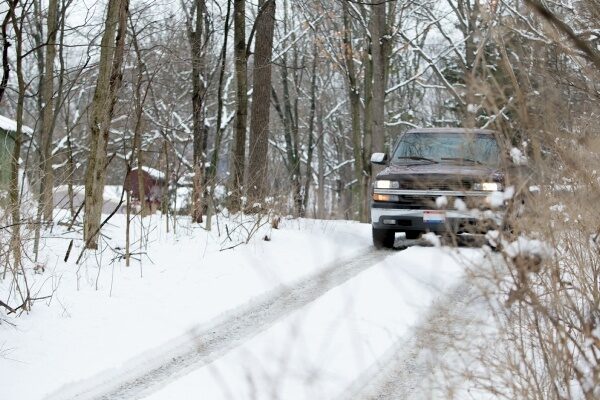
Taking time to prepare your car for winter weather is a smart way to help make time on the road safer and more comfortable.
Why car winterization is essential
Snow, ice and freezing temperatures can affect the way cars operate and make driving more difficult and hazardous. Ensuring your car is prepared for winter can help put you in the best possible position to safely navigate winter driving.
When should you winterize your car?
Planning ahead is the best rule of thumb for winterizing your car. While the arrival of winter conditions will vary based on where you live, starting on the checklist below in the autumn will help you be ready before the first icy blast.
Here are the 11 parts of your vehicle you should winterize to get ready for the cold.
1. Check antifreeze and the cooling system
- The cooling system and antifreeze/coolant keep your engine running well in cold temperatures, so it’s important that everything is working correctly.
- Follow the owner’s manual instructions to verify that your coolant/antifreeze is at the proper level and consider visiting a mechanic for a check of your cooling system. [1]
2. Check tires
- Colder temperatures can cause tire pressure to drop. To ensure you have optimal grip for winter driving, check tires at least once a month for the proper tread and recommended tire pressure (you’ll find the recommended tire pressure inside the driver’s side door, doorframe, or in the owner’s manual). [2]
- Replace worn tires.
- All-weather tires are generally sufficient for winter, but some states require vehicles to have tire chains or snow tires with studs, so make sure to check local laws. [3]
- If you live in an area prone to snow and ice, consider winter tires, which are designed to provide better grip in those conditions. [2]
3. Replace worn windshield wipers
- Install fresh windshield wiper blades to give you a clear view while driving in winter weather.
- Replace wiper fluid with a winter mixture and maintain the proper fluid level.
- Depending on your climate, consider winter wiper blades to help cut through snow and ice. [2]
4. Check brake pads and brake fluid
- Check brake fluid levels and brake pads for wear and tear. [4]
5. Test car battery
- Make sure battery cables and terminals are secure and free from corrosion.
- Consider having your battery tested by a mechanic, especially if it’s more than 4 years old. [4]
6. Check heater and defroster
- Turn your heater and defroster on and off to make sure they’re working correctly.
7. Clean foggy headlights
- Make sure all lights are clean and working properly.
- Clean lights off prior to driving in any type of precipitation.
- Replace headlights that are foggy, hazy or damaged to improve visibility. [4]
8. Check motor oil
- Change motor oil and filter at recommended intervals.
- Heavier oils thicken at lower temperatures and may not lubricate as well, so consider switching to “winter weight” or less viscous oil. [1]
9. Inspect exhaust system
- To help keep carbon monoxide out of the passenger compartment, have a mechanic check for leaks or faulty seals. [5]
10. Keep the gas tank at least half full, or the battery charged
- To help prevent fuel lines from freezing and to give you plenty of gas in case you’re stranded, keep your tank at least half full. [6]
- For electric and hybrid vehicles, keep your battery charged and consider keeping it plugged in overnight in the winter, which will keep the battery in an ideal temperature range. [2]
11. Wash your car periodically
- Prevent road salt from damaging your car’s paint by washing your car during the winter.
- Apply a fresh coat of wax to avoid corrosion.
- Consider winter floor mats to protect your car’s carpeting.
Along with these maintenance tips, ensure your vehicle has a winter emergency kit and the right auto insurance coverage before you hit the road this winter. For more information on how to keep yourself, your car and your home safe during the winter, explore Nationwide’s resources.
Any of the recommendations should only be done if consistent with the owner’s manual.
Sources:
[1] “It’s Time to Winterize! How to Get Your Car Ready for Colder Weather,” firestonecompleteautocare.com/blog/maintenance/winter-car-maintenance-checklist/# (Nov. 14, 2022).
[2] “Winter Weather Driving Tips,” National Highway Traffic Safety Administration, nhtsa.gov/winter-driving-tips (Accessed July 2024).
[3] “Tire Chain Laws and Regulations by State,” tirechain.com/tirechains-com-tire-chain-laws-and-regulations-by-state/ (Accessed July 2024).
[4] “How to Winterize Your Car,” autozone.com/diy/seasonal/winter-preparation-guide (Accessed July 2024).
[5] “Why Exhaust Inspections Are Crucial for Family Vehicles,” boyceautorepair.com/blog/why-exhaust-inspections-are-crucial-for-family-vehicles/ (May 6, 2024).
[6] “Prepare your vehicle for winter driving,” State of Wisconsin Department of Transportation, wisconsindot.gov/Pages/safety/education/winter-drv/vehicle.aspx (Accessed August 2024).
Disclaimer:
The information included is designed for informational purposes only. It is not legal, tax, financial or any other sort of advice, nor is it a substitute for such advice. The information may not apply to your specific situation. We have tried to make sure the information is accurate, but it could be outdated or even inaccurate in parts. It is the reader’s responsibility to comply with any applicable local, state or federal regulations. Nationwide Mutual Insurance Company, its affiliates and their employees make no warranties about the information nor guarantee of results, and they assume no liability in connection with the information provided. Nationwide, the Nationwide N and Eagle and Nationwide is on your side are service marks of Nationwide Mutual Insurance Company. © 2024 Nationwide



